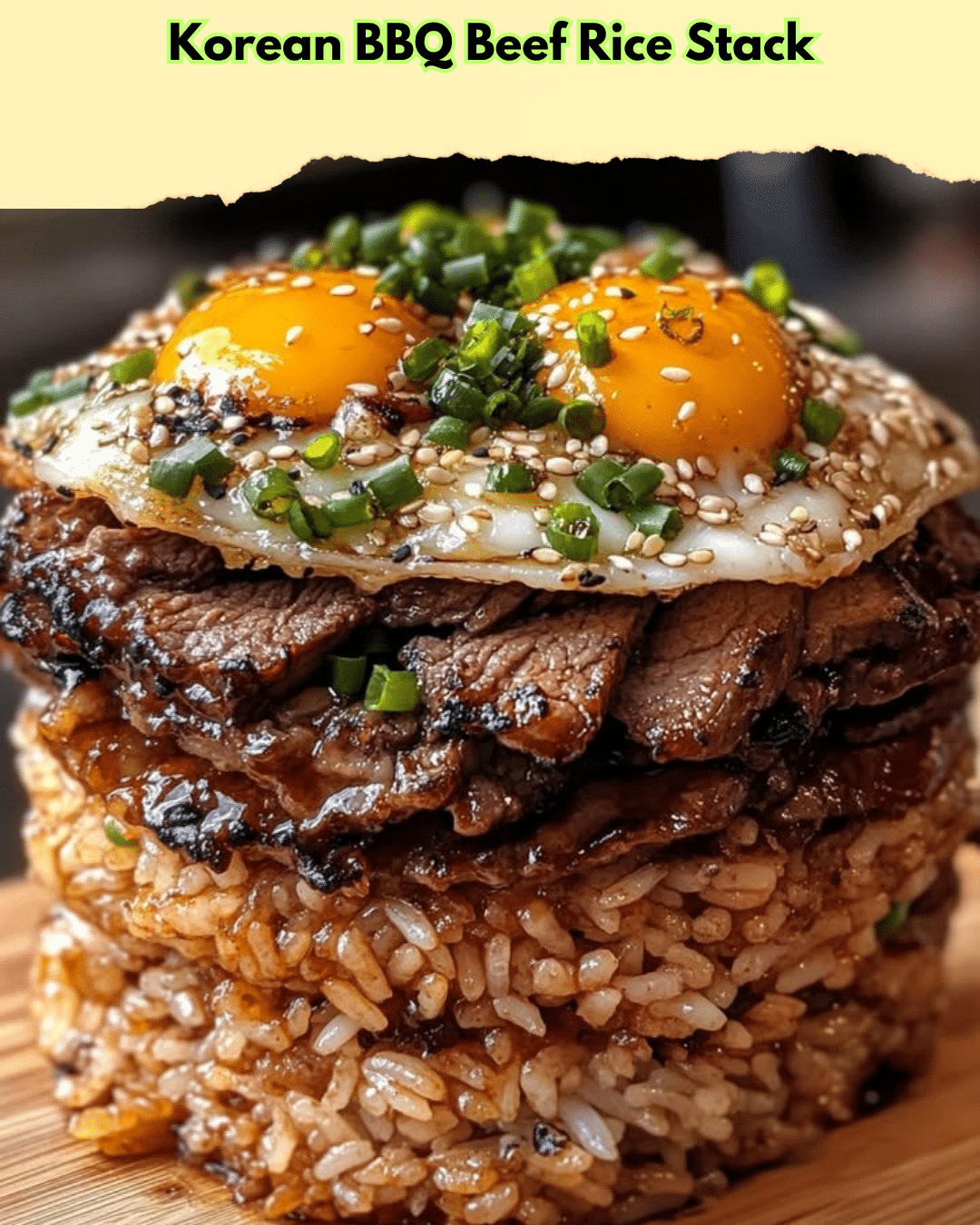Korean BBQ Beef Rice Stack: A Flavorful Culinary Adventure
Embark on a savory journey with our Korean BBQ Beef Rice Stack recipe, a delightful fusion of aromatic Korean BBQ flavors and the heartiness of a classic rice stack. This creative dish brings together tender slices of marinated beef and layers of perfectly cooked rice. The fusion of spicy, sweet, and savory profiles in this recipe will transform your dining experience into a culinary adventure that’s hard to resist. With every bite, enjoy the explosion of flavors that echo the vibrant culture of Korea, making this dish not only a meal but an exploration of taste and tradition.
Quick Recipe Highlights
- Flavor Profile: A rich blend of soy sauce, garlic, and ginger with a hint of sweetness and spice, offering a truly authentic Korean BBQ taste.
- Texture: The dish combines the juicy tenderness of the beef with the fluffy texture of rice, creating a satisfying bite every time.
- Aroma: Fragrant notes of garlic and sesame oil rise as the beef sizzles, enveloping your senses in a warm and inviting embrace.
- Visual Appeal: Perfectly grilled slices of beef rest atop a bed of steaming rice, garnished with vibrant green onions and sesame seeds.
- Skill Level Needed: This dish requires basic marinating and grilling skills, easily achievable by both novice and seasoned cooks.
- Special Equipment: A grill pan or BBQ grill is essential to achieve the perfect sear and char on the beef slices, enhancing flavor and presentation.
Recipe Overview
- Difficulty Level: This Korean BBQ Beef Rice Stack is classified as medium due to the necessity of precise timing in marinating and grilling techniques to achieve optimal tenderness and flavor.
- Category: This recipe falls into the ‘Main Course’ category, offering a hearty combination of proteins and carbohydrates to make for a filling meal.
- Cuisine: Rooted in Korean culinary tradition, this recipe highlights the influence of Korean BBQ with contemporary presentation styles such as the rice stack.
- Cost: As an affordable dish, the key ingredients such as beef, rice, and spices are reasonably priced, especially when sourced from local markets.
- Season: Enjoy this recipe all year round, though it’s especially delightful during the summer grilling season when you can barbecue outdoors.
- Occasion: Suitable for family dinners, casual gatherings, or celebratory feasts, this dish offers versatility in both flavor and presentation.
Why You’ll Love This Recipe
Our Korean BBQ Beef Rice Stack quickly becomes a favorite due to its engaging taste and texture appeal. The marinade’s perfect combination of soy sauce, garlic, and ginger creates a unique depth of flavor that balances between sweet, savory, and spicy. Paired with jasmine rice, this dish offers a complementary texture contrast that’s both satisfying and indulgent.
Convenience is another reason this recipe steals the spotlight. With advance preparation of the marinade, you can achieve restaurant-quality results in your home kitchen. The recipe stages are designed for efficiency, allowing you to focus more on enjoying the cooking process rather than stressing about timing.
Nutritionally, this dish is a powerhouse, offering a balanced protein-carbohydrate ratio. The beef is high in iron and vitamin B12, while the rice provides necessary carbs for energy. When paired with optional vegetables like bell peppers, it becomes a well-rounded meal.
The social value of sharing this meal cannot be overstated. Perfect for gatherings, it encourages communal dining and lively conversations, making it a social activity just as much as sustenance.
Finally, its cost-effectiveness and accessibility make it an attractive addition to the weekly menu. With straightforward ingredients that are easy to source, this recipe offers a premium dining experience without the premium price tag.
Historical Background and Cultural Significance
Korean BBQ, or “Gogi-gui” in Korean, has deep roots in Korean tradition, dating back to ancestral rituals where grilling meat was part of ceremonial offerings. This age-old practice evolved over centuries, becoming central to Korean social gatherings and celebrations.
Its cultural significance extends beyond sustenance; Korean BBQ is a celebration of family and friendship. The communal aspect of grilling and serving mirrors the collective spirit of Korean culture, where meals are shared and enjoyed together.
This recipe illustrates the evolution of Korean BBQ from traditional practices to modern adaptations. By transforming classic bulgogi into a stacked presentation, it melds historical flavors with contemporary aesthetics.
Regional variations abound in Korean BBQ, with different marinades and grilling techniques unique to specific provinces. This diversity reflects Korea’s rich culinary tapestry and ensures that each dining experience remains distinctly vibrant.
Ingredient Deep Dive
**Beef:** Central to our recipe, the choice of beef affects flavor and texture profoundly. In Korean cuisine, beef is revered, and its preparation involves meticulous marinating to enhance natural umami. Nutritionally, beef is a robust source of protein, vitamin B12, and iron, supporting muscle health and energy production.
**Rice:** A staple in Korean and global cuisines, rice provides a neutral palate to showcase the vibrant flavors of Korean BBQ. Culturally, it’s a symbol of prosperity and sustenance. It’s essential to store rice in a cool, dry place, and rinse it thoroughly to improve texture and taste.
Common Mistakes to Avoid
- Over-marinating the beef can lead to a mushy texture. Aim for a marinade window between 2 to 4 hours.
- Using high heat can cause the marinade sugars to burn. Medium heat ensures a balanced caramelization and juicy interior.
- Failing to pat the beef dry prior to grilling leads to steaming rather than searing, compromising flavor.
- Overcooking the beef will result in toughness. Aim for a medium-rare to medium doneness for optimal tenderness.
- Ignoring resting time after grilling can cause juices to run, dry out the beef. Let the beef rest for at least 5 minutes.
- Using the wrong cut of beef affects the final taste. Choose tender cuts like ribeye or sirloin for results.
- Skimping on garlic or ginger undermines the signature flavor profile. Maintain ingredient balance for authentic taste.
- Neglecting to slice beef against the grain results in toughness. Thin, grain-opposing slices improve tenderness.
Essential Techniques
– **Marinating:** This technique infuses the beef with depth of flavor globally appreciated in Korean BBQ. Optimal marinade penetration involves time and a uniform covering. Avoid overly salty mixtures which can dominate the beef’s natural flavor.
– **Grilling:** Achieving a perfect sear demands precise heat management and timing. Visual cues like caramelization along the beef’s edges signal readiness. Protect from over-charring which impairs taste and texture.
Pro Tips for Perfect Korean BBQ Beef Rice Stack
– Use cold rice to form firm stacks, ensuring a better platform for beef layers.
– Add a touch of sesame oil post-cooking to heighten the beef’s aroma and richness.
– Integrate a pinch of brown sugar in the marinade for enhanced caramelization.
– Allow the beef to reach room temperature before grilling for even cooking.
– Utilize a meat thermometer for precise temperature monitoring, ensuring doneness.
– Serve immediately to ensure the beef remains juicy, and the rice retains freshness.
– Incorporate a splash of vinegar in cooking rice for added fluffiness and taste.
Variations and Adaptations
Experiment with regional variations that fuse distinct ingredients such as kimchi for a spice boost or pineapple for sweetness. For seasonal flair, incorporate summer veggies like zucchini or bell peppers.
To accommodate dietary preferences, swap beef with tofu for a vegetarian version, without compromising the essence of Korean BBQ. Modify the flavor by adding chili flakes for more heat or honey for a sweeter profile. Adjust presentation by creating rice balls fully enveloped by beef for bite-sized servings.
Serving and Presentation Guide
Create a harmonious plate by layering rice neatly using a ring mold, adding aesthetic appeal. Garnish with fresh herbs like cilantro or green onions for a pop of color and flavor. Traditionally served with banchan (small side dishes), modern accompaniments can include a fresh salad or roasted vegetables for a nutritional upgrade. Ideal temperature for serving is warm, ensuring integrity of the rice and beef remains intact. Control portions with equal rice and beef distribution, avoiding dominance of any one component.
Wine and Beverage Pairing
A full-bodied red wine such as Cabernet Sauvignon or Malbec pairs beautifully, balancing the umami and sweetness of the stack. For non-alcoholic options, a refreshing iced green tea complements the flavors and cleanses the palate. If you enjoy coffee or tea pairings, a subtle jasmine tea offers light floral notes that mirror the dish’s elegance. Avoid highly carbonated drinks which may overshadow the dish’s delicate balance.
Storage and Shelf Life
Store any leftovers in an airtight container, keeping them refrigerated to maintain texture and flavor for up to three days. Ensure rice is separately contained to prevent it from getting mushy. Look for signs of spoilage like off odors or sliminess in the beef. For reheating, use a skillet over low heat or a microwave with a covering to trap moisture, preventing dryness. Although not ideal, freezing is possible if thoroughly sealed to prevent freezer burn; however, this may impact texture slightly.
Make Ahead Strategies
Advance preparation of the marinade up to two days prior enhances the flavor while making the cooking process seamless. Store the beef and rice separately to maintain texture integrity while stacking freshly before serving. Rest components at room temperature for even cooking and flavor harmony. Consider reheating the beef slightly in context to maintain juiciness without overcooking. Add fresh elements like green onions or sesame seeds just before serving for vibrancy.
Scaling Instructions
To halve the Korean BBQ Beef Rice Stack recipe, maintain marinade proportions to retain flavor intensity. Doubling involves ensuring even distribution on the grill for optimal cooking. Larger equipment may require a timely rotation of beef slices to ensure uniform doneness. Extended cooking time for larger quantities may deplete marinade moisture, requiring slight adjustments. Consider additional serving dishes to accommodate increased quantities without compressing stacks.
Nutritional Deep Dive
In this recipe, the macro breakdown offers approximately 400 calories per serving, supporting active lifestyles with proteins and healthy fats from the beef and sesame oil. Micronutrients like vitamin B, iron, and zinc bolster immune function and energy levels. Portion control plays a pivotal role in managing caloric intake without sacrificing the rich taste. Low sodium soy sauce conserves essential nutritional benefits while enhancing flavor. For weight management, consider a mixed greens side salad for fiber and satiety.
Dietary Adaptations
For a gluten-free variant, replace soy sauce with tamari or coconut aminos, which retain the umami essence without gluten presence. Dairy-free consumers easily align with this recipe due to absence of lactose-containing products. For a vegan twist, switch the beef with marinated tofu or seitan, delivering protein without animal products. Low-carb enthusiasts can substitute rice with cauliflower rice, maintaining flavor intensity while reducing carbohydrates.
Troubleshooting Guide
– Texture issues arise from overcooking—marinating longer aids tenderness, preventing toughness during grilling.
– Balance flavor by adjusting soy sauce and sugar levels based on personal taste, avoiding overwhelming saltiness or sweetness.
– Ensure the right grilling temperature to prevent the common pitfall of beef charring, achieving desired flavor without bitterness.
– Lack of grilling equipment challenges can be addressed by broiling in the oven or investing in an indoor grill.
– Substituting ingredients requires a nuanced approach to complement the signature Korean BBQ taste while adjusting seasonings to preference.
– Adjust timing considerations by avoiding over-marinating or cooking, maximizing juice retention and flavor infusion.
Recipe Success Stories
Community feedback celebrates the Korean BBQ Beef Rice Stack for its flavor intensity and ease of preparation, heralding innovation in home kitchens. Variations including pineapple or jalapeño add dimensions of flavor that spark lively culinary discussions. Readers appreciate the adaptability of this dish that caters to diverse dietary needs without sacrificing core flavors. Photography tips include capturing the vivid layering and garnishing elements, ensuring the presentation translates visually. Enjoy the satisfaction of creating a blend of tradition and modern culinary excellence on one plate.
Frequently Asked Questions
1. Can I use a different cut of beef for the Korean BBQ Beef Rice Stack?
Yes, you can use tender cuts such as sirloin or tenderloin; however, ribeye is preferred for its marbling, enhancing flavor.
2. Is there an alternative to using a grill?
If a grill isn’t available, use a grill pan or broiler to achieve similar results, adjusting time to prevent overcooking.
3. How can I ensure the rice doesn’t become too sticky?
Opt for short-grain rice and rinse it thoroughly before cooking to remove excess starch, achieving ideal texture.
4. What should I do with leftover marinade?
Discard used marinade to prevent bacterial contamination; however, save a portion before adding meat for optional sauce.
5. Can I prepare this dish without sesame oil?
Yes, substitute with vegetable or olive oil, though note sesame oil imparts distinct traditional flavors.
6. How long should I rest the beef after grilling?
A rest period of five minutes ensures the beef retains its juices, contributing to flavor and tenderness.
7. Is it possible to use brown rice instead of white rice?
Brown rice is a nutritious substitute, though it requires longer cooking time and may impact overall flavor.
8. What are some garnishing alternatives?
Explore garnishes such as toasted sesame seeds, sliced almonds, or microgreens for added texture and visual appeal.
9. How can I adjust the spiciness level?
Control spice using chili paste or flakes. Adjust to personal preference while considering balance with other ingredients.
10. Can the dish be made ahead of time and reheated?
Prepare components ahead and assemble just before serving, but avoid long-term reheating to maintain integrity.
Additional Resources
Explore related recipes that delve into the world of Korean cuisine, such as kimchi jeon or bulgogi bowls. Access technique guides on perfect grilling strategies to enhance your culinary skills. Delve into ingredient profiles to understand the nuances of Korean flavors and how they integrate into global dishes. Review equipment recommendations to optimize your cooking process, and investigate seasonal variations that highlight the dish’s versatility across different climates and produce availability.
Print
Korean BBQ Beef Rice Stack
Description
A delicious stack of marinated BBQ beef served over fluffy rice with a drizzle of spicy gochujang sauce.
Ingredients
For the Crust:
- 1 pound beef sirloin, thinly sliced
- 2 cups cooked jasmine rice
- 2 tablespoons soy sauce
- 2 tablespoons sesame oil
- 1 tablespoon sugar
- 2 cloves garlic, minced
- 1 teaspoon ginger, grated
- 1 tablespoon gochujang (Korean chili paste)
- 1 tablespoon rice vinegar
- 1 tablespoon green onions, sliced
Instructions
1. Prepare the Crust:
- In a bowl, combine soy sauce, sesame oil, sugar, garlic, and ginger. Add beef slices and marinate for at least 30 minutes.
- Heat a skillet over high heat and cook the marinated beef until it’s browned, about 5-7 minutes.
- To assemble the stack, place cooked rice on a plate, top with cooked beef, and drizzle with a mixture of gochujang and rice vinegar. Garnish with sliced green onions.
Notes
You can customize the seasonings to taste.




